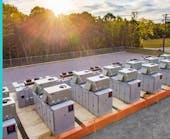Is Electrification the Holy Grail for Decarbonization?
As the CEO of a company that advises manufacturers on how to lower environmental emissions and reduce energy consumption, Doug Bloss is qualified to answer the question in this article’s title. Bloss’ company, Armstrong International, is working with some of the world’s largest consumer packaged goods and pharmaceutical manufacturers to help them decarbonize their operations. In addition to answering the above question, Bloss recently shared with EnergyTech his insights on the technologies these manufacturers are using to decarbonize, how these large energy buyers are teaming up to scale up the efficiency of renewables, and more. Read on for his perspective.
EnergyTech: From a manufacturing standpoint, what are some key operational similarities among consumer packaged goods and pharmaceutical producers?
Doug Bloss: Consumer packaged goods processors share the same regulating body with pharmaceutical producers, which are controlled by the FDA (U.S. Food and Drug Administration), the highest safety and quality regulator in the world. Many manufacturers produce critical items for everyday life, which demonstrates the necessity for them to continue performing at a high level. However, operations typically use traditional forms of energy such as coal, oil, and natural gas as these are accessible and inexpensive. While these methods have worked to build and maintain these essential industries, they will not sustain them. Ranging from small, local companies to large, global corporations, thermal utility management today is in higher demand, where efficiency, energy, and emissions are taking center stage.
ET: How are their energy demands similar, and how are these demands evolving amid the drive to decarbonize operations?
Bloss: Consumer packaged goods processors and pharmaceutical producers also share similar demands of their energy systems operating personnel. From rigorous compliance requirements, to documentation, to real-time monitoring, and consistent, reliable performance expectations, the energy demands are higher than ever as our world continues to produce more materials at a faster rate – all while working to keep operational costs low. Amidst the decarbonization movement, evolved processes are taking place such as utilizing low- and medium-grade heat to convert hot water to permit the substitution of fossil-fueled thermal with industrial heat pumps.
ET: What are some energy technologies that are helping these manufacturers to decarbonize?
Bloss: There are some attractive developments in thermal storage and heat recovery systems that would permit recovery of waste heat from the most thermally intense processes for use elsewhere in a diverse process facility. Advancements in digital mixing technology enable precise hot water temperature control to comply with sanitation requirements and other temperature-sensitive processes.
From trap management, to monitoring and measurement, to heat transfer, much of how new technologies are sprouting begins with a tiered approach of optimizing, minimizing, and finally decarbonizing. This is our methodology at Armstrong International and we continue to look for new ways to assist with this process
In 2016, we introduced “SAGE,” the most powerful platform for thermal utility system management available. With the help of SAGE, our customers have identified over 2 billion pounds per year in CO2 savings and $150 million in potential steam loss savings.
More recently with SAGE, we also partnered with batteryless Internet of Things company Everactive to further optimize valuable steam systems that are at the heart of process manufacturing, petrochemical refining, and district energy operations. The integration of Everactive and SAGE software is a powerful one-two punch of new technology and industrial domain expertise that stands to drive tremendous savings.
ET: Are these energy technologies falling short in any respects? In other words, is there a “wish list” of energy technologies and/or energy sources that could enhance their march toward net-zero emissions?
Bloss: In terms of a “wish list,” it would be remarkably convenient if hydrogen infrastructure development could be accelerated. “Green hydrogen” generation capacity and transportation pipelines would permit substitution of widely used fossil fueled thermal systems.
ET: You’ve argued that electrification is not the “holy grail” for decarbonization. Please elaborate.
Bloss: Real-world solutions will have multiple complex components working together over time. Where electrification may work for some organizations, it is not necessarily sustainable for others. The right solution differs from customer to customer, plant to plant, and at Armstrong we believe there isn’t a one-size-fits-all solution.
In the earliest days of this journey, we are observing wide swings in renewable electric pricing, as demand far outpaces supply. Decarbonization is a “techno-economic” challenge – technology choices exist but they must be evaluated against business risk, available natural resources, and life cost to arrive at the right solution – especially with multinationals operating in different markets across the globe. Ultimately, the right solution must be “technology agnostic” and begin with a comprehensive utility assessment of the facility.
Electrification will play a large role in decarbonization but will be limited as the demand for this increased power is growing faster than it can be produced or what our current electrical grid can support. In fact, this demand is growing by a factor of two to four.
ET: Along the lines of your stance on electrification, what are some ways that consumer packaged goods and pharmaceutical producers – and, by extension, other large energy consumers in manufacturing – can decarbonize with non-thermal as well as thermal energy sources? In short, what’s the realistic happy medium?
Bloss: A mix of non-thermal and thermal energy sources can be a realistic happy medium. Producing heat using renewable energy sources such as renewable electricity and gas, hydrogen, biomass, geothermal, solar and thermal storage, and solutions surrounding electrification have shown to improve efficiency. For example, partial electrification of low-grade heat using high-temperature industrial heat pumps with green refrigerant is a mix of both that still leads toward decarbonization.
ET: Would you like to add any comments?
Bloss: We are taking a proactive approach to decarbonization efforts and recently began a sponsor of the Renewable Thermal Collaborative (RTC). The RTC is the leading global coalition for organizations committed to scaling up renewable efficiencies. We join a prestigious list of members, including some of the world’s largest food and pharmaceutical manufacturers as we advance our global effort to support companies and industries charting a course toward net-zero emissions.





